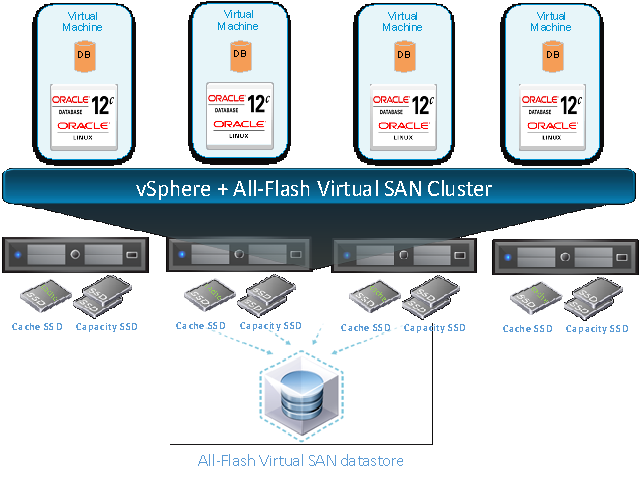Hey Oracle on VMware folks!!!
Earlier, we had blogged about Oracle RAC on VMware Virtual SAN Hybrid which is VMware’s software-defined storage solution for hyper-converged infrastructure and is available at Oracle RAC on Hybrid VSAN
In this blog post, we would like give you a glimpse of “Oracle 12c OLTP Workload on VMware Virtual SAN 6.2 All-Flash.
As some of you may know, in VMware Virtual SAN 6.2, we introduced a suite of new features for data integrity and space efficiency including Checksum, Erasure Coding, Deduplication and Compression. Using these features we developed an architecture for deploying and running Oracle 12c OLTP and DSS workloads on VMware All Flash Virtual SAN 6.2.
Before going into some of the results, let’s take a look as to why it is compelling to deploy heavy IO Oracle workloads on a VMware Virtual SAN All Flash solution.
- Extreme Performance – Virtual SAN is built into the vSphere kernel which optimizes the I/O path to provide excellent performance.
- Built in Data Reduction Technologies – Deduplication, Compression and Erasure Coding reduces data footprint and lowers cost, both capex and opex, further lowering the TCO of the solution.
- Availability for Business Critical Applications – Minimizes downtime with features like vMotion, vSphere HA, Virtual SAN Stretched Clustering.
- Redundancy for Business Critical Applications – Provides high level of redundancy thereby avoiding single point of failures (SPOF) with features like Failure to Tolerate (FTT), Fault Domain
Oracle 12c OLTP on Virtual SAN All Flash 6.2 Solution test environment
We built out a 4-node All Flash Virtual SAN Cluster with two Virtual SAN disk groups in each ESXi host, 2 different VM sizes (Medium=4 vCPU/64GB RAM and Large=8 vCPU/96GB RAM) were used. Oracle Linux 7.0 operating system was used for database VMs with Oracle 12c Database (12.1.0.2.0) as the database version.
OLTP Oracle workload using SLOB
This test focusses on extremely heavy Oracle OLTP like workload behavior on Virtual SAN.
SLOB was used to generate the OLTP workload against each of the 4 Oracle VMs for 60 minutes (2 Large VMs and 2 Medium VMs). Workload was a mix of 75% reads and 25% writes to mimic a transactional database workload.
A VM was placed on every ESXi host in the 4 node Virtual SAN cluster as shown in the figure below.

Several Virtual SAN configurations were tested to understand the IO performance and resource consumption using the new features in Virtual SAN 6.2.
For this blog, we’ve extracted 2 of those test configurations. First is the baseline R1; this is a configuration without any new features enabled. The second configuration is (R15+C+SE) with several features enabled in 6.2.
The below table provides the details for these configurations.

The below test results are specific to the configuration setup used in this solution and the SLOB workload deployed.

OLTP Baseline (R1) Performance:
Virtual SAN Configuration R1 is used as the baseline performance for the OLTP tests. In the baseline test, IOPS generated by the four oracle database VMs during the test reached a peak of 100,000 IOPS with average of 95,000 IOPS.
The total storage used was around 3.7TB without Space Efficiency features (Compression, Deduplication & Erasure Coding)
This shows that Virtual SAN storage provides a reliable performance for a business critical application like Oracle despite high intensity of the workload. R1 Configuration test shows the average read and write latency is 4ms and 17ms respectively. Latency is relatively low for this solution considering the extremely heavy IOs generated concurrently by four oracle databases.
OLTP R15+C+SE Performance:
This configuration is a common practice used in industry, where the log disk is mirrored using RAID 1 and data disks are configured for Raid 5. This provides substantial space savings offered by Erasure Coding.
Since Erasure coding is a storage policy it can be independently applied to different virtual machine objects providing simplicity and flexibility for configuring this type of workload. While erasure coding provides a predictable amount of space savings, deduplication and compression provides a varying amount savings. The space saving obtained due to deduplication and compression is highly dependent on the application workload and data set composition.
With the Space Efficiency Features enabled, VMware Virtual SAN is still able to deliver over 72,000 IOPS, a reduction of 24 percent with respect to the Baseline (R1).
However, this configuration provided the space efficiency of over 50% reducing the space consumed to 1.7TB which was contributed by Erasure Coding (R5), Deduplication and Compression.
Remember, the total storage used in the OLTP Baseline (R1) baseline test was around 3.7TB without Space Efficiency features (Compression, Deduplication & Erasure Coding).
The average read and write latency observed was 6.3ms and 23.6ms respectively. This test was run under peak IO utilization scenario with concurrent workload from 4 OLTP databases. Typical real-world environments should have lower I/O latencies. This Virtual SAN configuration (R15+C+SE) provided the best combination of performance and storage efficiency
During this test
- Resource overhead (CPU and Memory) observed due to space efficiency and checksum feature was minimal
- Average ESXi CPU utilization increase in the R15+C+SE was minimal (3.1% percent)
- Memory overhead was negligible.

The above tests validate VMware Virtual SAN as a viable option for running extremely heavy Oracle workload with space efficiency features released in Virtual SAN 6.2 lowering the TCO.
The reference architecture also goes into Oracle DSS like workloads on All Flash Virtual SAN 6.2
The reference architecture paper can be found here .





